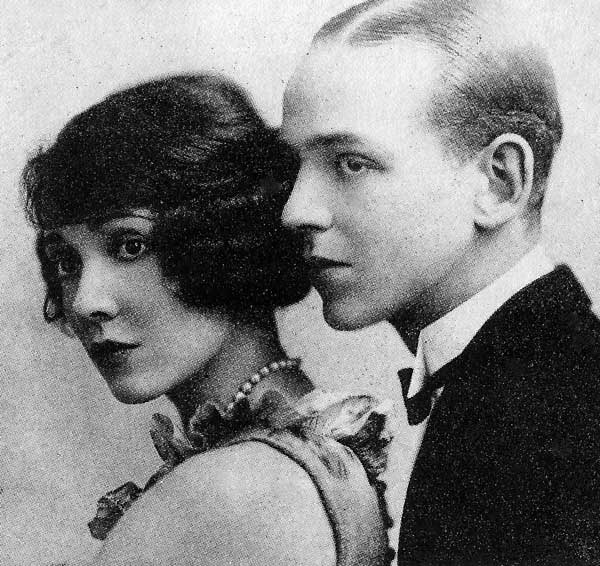Fred And Delly
It was never written that Fred Astaire would be a movie star. Sure, talkies came in when his Broadway stardom was at its height, but Fred was slight of build and balding, with big ears and a weak chin, not to mention a thin, reedy voice. Hollywood wasn't beating down his door, and if he had the wrong material in his first project or two, he'd now be a footnote in film history, instead of the screen's greatest song-and-dance man.
But he'd be remembered in the theatre, where he and sister Adele (whose birthday is today) were an electfying team who epitomized the Jazz Age. And, presumably, after she left the act, he'd have gone on for decades as a charming, talented leading man. However, this team's work is lost to the ages, and can only be recreated by reading old reviews, listening to a few old recordings, and staring at old photographs. Happily, Kathleen Riley has done some research and come up with her book The Astaires, painting a picture of this dazzling team. It's a short book, less than 200 pages of text, but it lays out just what they did and why they were famous.
They started in show biz as children. Born in the 1890s, they were thrust into Vaudeville by their estranged parents, who lived through them vicariously (and, in certain periods, financially). Born in Nebraska, they moved with their mother to New York, where they trained and soon became a successful act. Adele was a bit older and generally considered the star. During their years of growing pains, the act had to change and for some time they left the stage, but returned and worked their way back to the top.
By the late 1910s, when they were young adults, Broadway producers took a liking to them and they worked as featured dancers, generally stealing any show they were in. Especially big was their wacky "run-around" exit which they put into more than one production. They represented a youth, charm and vitality that few could match and soon were starring in their own shows, introducing classic songs and routines, often with music by that other 1920s examplar, George Gershwin.
They took their shows to London and became even bigger there. It's hard to overstate how huge the reception was. This was a Britain beaten down by World War I, and the Astaires represented the excitement and hope of the modern age, and the New World. They were feted not only by the critics, but by the intelligentsia and royalty.
Whether in New York or London, they rarely made a wrong step (though signing up to do Smiles with the old-fashioned Flo Ziegfeld produced a rare flop in 1930). Since we have no film of Adele performing, we can only guess that she must have possessed some magic. She wasn't a great beauty, nor a great singer, but she was effortlessly charming. (She also didn't work as hard as Fred for the effect. He was known as Moaning Minnie, while she was Goodtime Charley.) But it's not as if Fred wasn't noticed He would sometimes exaggerate in later years how he was a lesser light, but the critics recognized he was a great dancer and even a fine comic actor.
Adele, in the early 30s, was ready to leave show biz and marry Britain's Lord Cavendish, but she wanted to go out in a hit. The Astaires got one with one of the greatest revues in Broadway history, The Band Wagon. After she was gone, her brother went out on his own in Gay Divorce--a show not well-reviewed, but featuring the giant Cole Porter hit "Night And Day" and proving Fred could hold his own. When he brought the show to London, his sister was in the audience and surprised at how her former partner had become a sex symbol.
Soon after he became a major Hollywood star. Adele was still offered roles on stage and in movies, but she turned them all down. Her marriage, however, was not a happy one. She had a stillbirth and a miscarriage, all while her husband sank into the alcoholism that would kill him before he was forty. Fred married and moved to Los Angeles, which probably increased Adele's loneliness in her castle in Ireland. Fred, somewhat against his will, was teamed up with another partner. Though he couldn't know it at the time, Ginger Rogers, not Adele, would be the name to which he'd become inextricably linked.
As brother and sister, they remained close through the years (and their stage mother Ann stayed involved as well), even as they were far apart physically. Fred's worldwide fame makes any book about their career as a team a prologue, but it's good to know there once was a great duo known as the Astaires.


0 Comments:
Post a Comment
<< Home